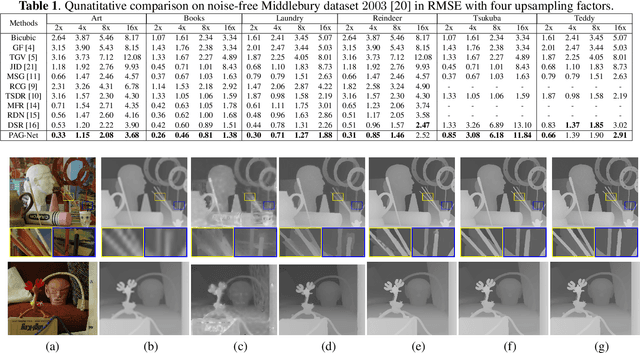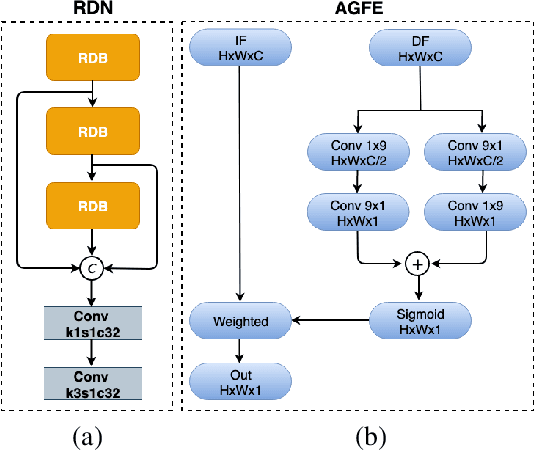Rajiv R. Sahay
PAG-Net: Progressive Attention Guided Depth Super-resolution Network
Nov 22, 2019



Abstract:In this paper, we propose a novel method for the challenging problem of guided depth map super-resolution, called PAGNet. It is based on residual dense networks and involves the attention mechanism to suppress the texture copying problem arises due to improper guidance by RGB images. The attention module mainly involves providing the spatial attention to guidance image based on the depth features. We evaluate the proposed trained models on test dataset and provide comparisons with the state-of-the-art depth super-resolution methods.
My camera can see through fences: A deep learning approach for image de-fencing
May 18, 2018



Abstract:In recent times, the availability of inexpensive image capturing devices such as smartphones/tablets has led to an exponential increase in the number of images/videos captured. However, sometimes the amateur photographer is hindered by fences in the scene which have to be removed after the image has been captured. Conventional approaches to image de-fencing suffer from inaccurate and non-robust fence detection apart from being limited to processing images of only static occluded scenes. In this paper, we propose a semi-automated de-fencing algorithm using a video of the dynamic scene. We use convolutional neural networks for detecting fence pixels. We provide qualitative as well as quantitative comparison results with existing lattice detection algorithms on the existing PSU NRT data set and a proposed challenging fenced image dataset. The inverse problem of fence removal is solved using split Bregman technique assuming total variation of the de-fenced image as the regularization constraint.
Towards an Automated Image De-fencing Algorithm Using Sparsity
Dec 10, 2016



Abstract:Conventional approaches to image de-fencing suffer from non-robust fence detection and are limited to processing images of static scenes. In this position paper, we propose an automatic de-fencing algorithm for images of dynamic scenes. We divide the problem of image de-fencing into the tasks of automated fence detection, motion estimation and fusion of data from multiple frames of a captured video of the dynamic scene. Fences are detected automatically using two approaches, namely, employing Gabor filter and a machine learning method. We cast the fence removal problem in an optimization framework, by modeling the formation of the degraded observations. The inverse problem is solved using split Bregman technique assuming total variation of the de-fenced image as the regularization constraint.
Stereo image de-fencing using smartphones
Dec 05, 2016



Abstract:Conventional approaches to image de-fencing have limited themselves to using only image data in adjacent frames of the captured video of an approximately static scene. In this work, we present a method to harness disparity using a stereo pair of fenced images in order to detect fence pixels. Tourists and amateur photographers commonly carry smartphones/phablets which can be used to capture a short video sequence of the fenced scene. We model the formation of the occluded frames in the captured video. Furthermore, we propose an optimization framework to estimate the de-fenced image using the total variation prior to regularize the ill-posed problem.
Deep learning based fence segmentation and removal from an image using a video sequence
Oct 21, 2016



Abstract:Conventional approaches to image de-fencing use multiple adjacent frames for segmentation of fences in the reference image and are limited to restoring images of static scenes only. In this paper, we propose a de-fencing algorithm for images of dynamic scenes using an occlusion-aware optical flow method. We divide the problem of image de-fencing into the tasks of automated fence segmentation from a single image, motion estimation under known occlusions and fusion of data from multiple frames of a captured video of the scene. Specifically, we use a pre-trained convolutional neural network to segment fence pixels from a single image. The knowledge of spatial locations of fences is used to subsequently estimate optical flow in the occluded frames of the video for the final data fusion step. We cast the fence removal problem in an optimization framework by modeling the formation of the degraded observations. The inverse problem is solved using fast iterative shrinkage thresholding algorithm (FISTA). Experimental results show the effectiveness of proposed algorithm.
 Add to Chrome
Add to Chrome Add to Firefox
Add to Firefox Add to Edge
Add to Edge